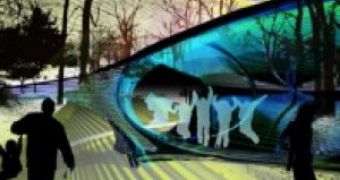As it is quite clear to everyone, children tend to have much more energy than grownups typically do, and this energy mostly manifests itself when they start playing.
Therefore, it should come as no surprise that environmentalists who are dead set on making the most out of whatever energy source they can get their hands on figured our a way to put the kids' hyperactive nature to very good use.
Thus, Margot Krasojevic from Belgrade, Serbia, came up with a revolutionary design: the Piezoelectric Playground, soon to be put to work in Pioneer's Park.
As earthtechling.com reports, the main idea is to build a structure which has semiconducting piezoelectric crystal disks inserted in its foundation. Since piezoelectric crystals generate piezoelectricity in response to mechanical stress, the movements made by children when playing can successfully be used to create electric energy.
The resulting energy can then be used to make sure that the playground is well-lighted as the night sets in, without having to resort to the national grid for power.
Interestingly enough, not just movements, but also vibrations can be used to generate energy in this manner. This means that on-going traffic can also add to the electricity produced in this playground.
However, what is most appealing about this state-of-the-art playground is that the light you get from the piezoelectric crystals is by no means even remotely similar to the one coming from your ordinary light-bulbs.
On the contrary, the playground is to also have a canopy made entirely out of optic fiber cables, which means that, as the kids go on playing, so will the light above them.
Apparently, the Piezoelectric Playground can also be adapted to house various concerts, in which case the band's movements on the stage and the vibrations caused by the musical instruments will be responsible for generating light.
All things considered, Margot Krasojevic's invention is sure to make quite an impression on the general public, and perhaps similar designs will also appear in other parts of the world.

 14 DAY TRIAL //
14 DAY TRIAL //